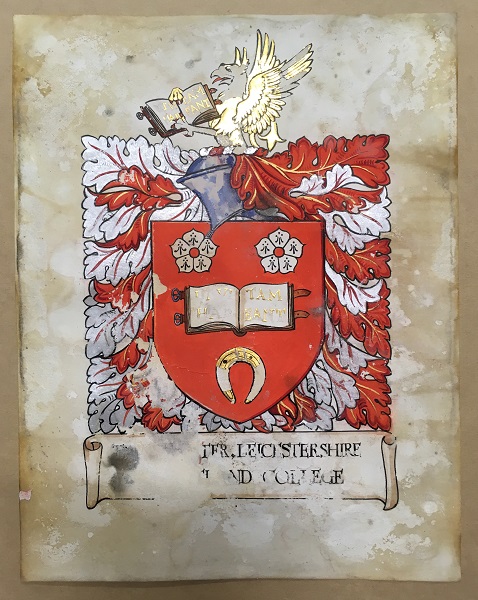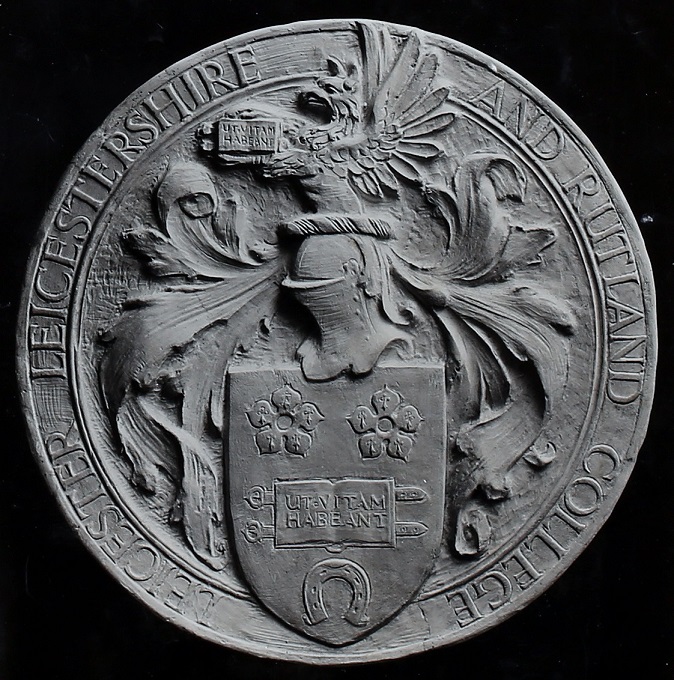A history and meaning of the Latin motto and the Coat-of-Arms of the University of Leicester (formerly a University College).
Coat-of-Arms
Our Coat-of-Arms was considered by the original Academic Committee in the months preceding the opening of the University in October 1921. The local Art School sculptor, Joseph Herbert Morcom, offered to design a seal or Coat-of-Arms for us, and the College accepted this offer in July 1921.
By the end of August 1921, Morcom had presented a model, and the Principal, Dr Rattray, resolved to check with the College of Heralds as to the accuracy required. A revised model was produced, and the arms were granted by the College of Arms on 3rd April 1922. In the meantime, the Committee was thinking about an appropriate motto, and College Colours.

The Coat-of-Arms was drawn up in paint and gold on vellum, and is still in the University’s Archives and Special Collections. This was displayed to the public on one of the College stalls at the Grand Bazaar and Fete held in May 1922 to raise funds for the College.

Heraldry
The description of the heraldry as stated in the Grant from the College of Arms (shown at the top of this page) was “Gules an open book strapped proper and buckled and inscribed with the words ‘Ut Vitam Habeant’ in letters Or between in chief two cinquefoils pierced Ermine and in base a horse shoe also Or And for the Crest on a Wreath of the Colours Argent and Gules A demi Gryphon segreant Or holding between the claws an open book as in the arms…”

In a local paper of Thursday 11th May 1922, the symbolism was explained as “The open book symbolises a seat of learning. One of the cinquefoils represents the city and the other the county. The horseshoe represents Rutland. The demi-gryphon which surmounts the design is taken from the arms of the late Mr T Fielding Johnson.”
Heraldic terms explained
The two Cinquefoils, or five-petalled flowers, are coloured Ermine – one of the four heraldic ‘fur’ colours – which is white with black ermine fur spots. The flowers are Pierced, so have a hole at their centre. In Chief signifies the top horizontal third of the shield; and the horse shoe in Base is in the bottom third. The ermine Cinquefoil was the heraldic emblem of the ancient Norman earls of Leicester; it was used on the former town arms and continues to feature today on the arms of both the City of Leicester and Leicestershire County Council. The open book Proper means it is shown in its natural colours, but the letters of the motto are in gold. Gules = red, Or = gold or yellow, Argent = silver or white. The University’s crest is the top part of the Coat-of-Arms. It is a gold demi-Gryphon Segreant, which means that its wings are open. The mythical beast sits on top of a helm, and different styles of helmet denote the aristocratic ranking of the bearer. The red and white strands flowing from the helm are called mantling and represent the length of fabric that would hang from the back of the knight’s helmet. The Wreath was used to fix the crest onto the helm. Heraldry developed in the early medieval period because, with the advent of the closed helmet which obscured facial features, knights on the battlefield needed to be distinguished from one another.
Motto
Suggestions for the College motto were put forward and the final choice was Dr Rattray’s suggestion of Ut vitam habeant (“That they may have life”). It was intentional that it could be interpreted in different ways, so that it made reference both to those who served and died in the First World War, those who survived and suffered or endured, as well as those that would come after (whom they intended would reap benefits from higher education in Leicester). The motto was adopted in February 1922.